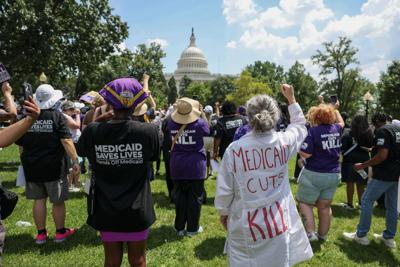
Care workers with the Service Employees International Union (SEIU) chant, rally outside the US Capitol on June 26, 2025 in Washington, DC. They came to denounce the impact to patients, families and workers if Republicans cut Medicaid, healthcare and SNAP to pay for tax cuts for the wealthy. (Photo by Tasos Katopodis/Getty Images for SEIU)
On Wednesday, President Donald J. Trump signed a stopgap spending measure approved earlier by the House of Representatives, bringing an end to the longest government shutdown in American history.
The bill, which passed the House by a vote of 222 to 209 largely along party lines, will keep the government funded through Jan. 30. The measure cleared Congress after weeks of tense negotiations that left hundreds of thousands of federal employees furloughed or working without pay.
The new spending measure maintains last year’s funding levels for most federal agencies until the end of January, while also allocating funds for specific departments through next September. This includes financing for the Supplemental Nutrition Assistance Program (SNAP), which supports approximately one in eight Americans.
Federal workers are expected to start returning to work as early as Thursday. The legislation also reinstates employees who were fired by Trump during the shutdown and guarantees back pay to affected federal employees.
However, Democrats are facing significant criticism from constituents for the unresolved issue at the center of the shutdown: the impending expiration of enhanced Affordable Care Act subsidies set to end this year.
The 43-day government shutdown was largely seen as a political strategy to secure the extension of health insurance subsidies that are set to expire next month. As part of the deal brokered with a bipartisan group of senators, Senate Majority Leader John Thune, Republican of South Dakota, agreed to schedule a mid-December vote on a Democratic proposal that would extend those subsidies.
Still, if Congress does not take action, there is a possibility that the subsidies could expire without a viable replacement. As a result, an estimated 4 to 4.8 million Americans could become uninsured. Coverage is expected to become less affordable for subsidized enrollees, with the annual out-of-pocket premium for the average subsidized household estimated to more than double from $888 in 2025 to $1,904 in 2026, according to The Kaiser Family Foundation.
In California, Latinos are expected to be one of the most affected populations. Latinos have been among the most significant beneficiaries of the ACA, particularly in states with large Hispanic populations such as California, Texas and Florida, according to Voto Latino.
For thousands of working-class families, access to affordable coverage has often meant the difference between stability and access to life-saving healthcare.










(0) comments
Welcome to the discussion.
Log In
Keep it Clean. Please avoid obscene, vulgar, lewd, racist or sexually-oriented language.
PLEASE TURN OFF YOUR CAPS LOCK.
Don't Threaten. Threats of harming another person will not be tolerated.
Be Truthful. Don't knowingly lie about anyone or anything.
Be Nice. No racism, sexism or any sort of -ism that is degrading to another person.
Be Proactive. Use the 'Report' link on each comment to let us know of abusive posts.
Share with Us. We'd love to hear eyewitness accounts, the history behind an article.